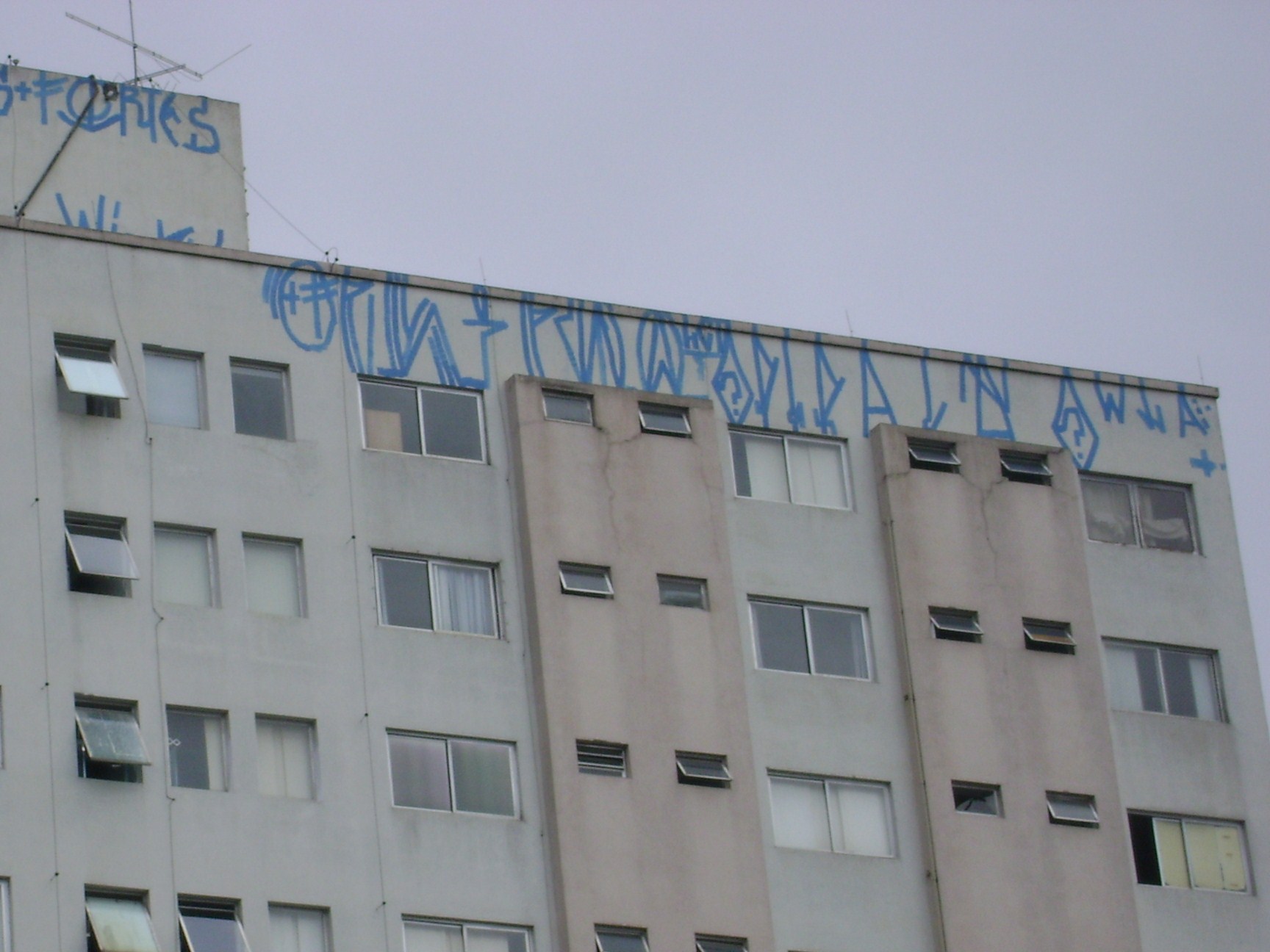Pichação on:
[Wikipedia]
[Google]
[Amazon]
 Pichação, sometimes misspelled as pixação (), is the name given to Brazilian
Pichação, sometimes misspelled as pixação (), is the name given to Brazilian
What is pichação?
From the
www.seidaris.de
German artist analyzing Pichação and interpreting it into western form. {{DEFAULTSORT:Pichacao Graffiti and unauthorised signage Brazilian art Culture in São Paulo
 Pichação, sometimes misspelled as pixação (), is the name given to Brazilian
Pichação, sometimes misspelled as pixação (), is the name given to Brazilian graffiti
Graffiti (plural; singular ''graffiti'' or ''graffito'', the latter rarely used except in archeology) is art that is written, painted or drawn on a wall or other surface, usually without permission and within public view. Graffiti ranges from s ...
. It consists of tagging done in a distinctive, cryptic style, mainly on walls and vacant buildings. Many ''pichadores'' (''pichação'' painters) compete to paint in high and inaccessible places, using such techniques as free climbing
Free climbing is a form of rock climbing in which the climber may use climbing equipment such as ropes and other means of climbing protection, but only to protect against injury during falls and not to assist vertical or horizontal progress. T ...
and abseiling
Abseiling ( ; ), also known as rappelling ( ; ), is the controlled descent of a steep slope, such as a rock face, by moving down a rope. When abseiling the person descending controls their own movement down the rope, in contrast to low ...
to reach the locations. Pichação is mostly condemned both by the society and the government since it is a crime. However, there is a difference between pichação and graffiti in Brazil, with graffiti being considered a form of art (as long as the property's owner agrees to have the wall graffited), while pichação is not appreciated by the majority of the society.
History
''Pichação'', known also as "wall writings", began in the 1940s and 50s as political statements written in tar and "were often written in response to the slogans painted by political parties across the streets."Manco, Tristan, Lost Art, and Caleb Neelon; "Graffiti Brasil", Thames & Hudson, London, 2005 () "Piche" is the Portuguese word for pitch or tar, and ''pichação'' originally meant writing in pitch. In the 1970s, ''pichação'' almost disappeared, but it was revived in the 1980s by a group of youths who began writing their names, and the names of their crews, instead of political slogans. ''Pichação'' has been described as a "vehicle for the youth of the city to assert their existence and self-worth, and to do it loudly. As a social protest, Pichação is brutal, effective and pulls no punches. There is no country on earth with a worse distribution of wealth than Brazil. For the rich, there are nice buildings. For the poor, there are shanty towns. Pichação exists on the very surface of the contested wealth, and promises to keep on punishing the fortunate until they produce a world less punishing to begin with." Brazilian pichação differs from other graffiti styles with its thin and aggressive letters. In the recent years, pichação is progressively changing its status, being more and more recognized as the art it is. Since 2019 ''pichação'' has also appeared inDublin
Dublin (; , or ) is the capital and largest city of Ireland. On a bay at the mouth of the River Liffey, it is in the province of Leinster, bordered on the south by the Dublin Mountains, a part of the Wicklow Mountains range. At the 2016 ...
, Ireland
Ireland ( ; ga, Éire ; Ulster-Scots: ) is an island in the North Atlantic Ocean, in north-western Europe. It is separated from Great Britain to its east by the North Channel, the Irish Sea, and St George's Channel. Ireland is the s ...
, due to the large number of Brazilians in the city.
Methods
Although its name is derived from the word for tar, many of the "pichadores" (those who do ''pichação'') in São Paulo use a 2-3 inch foam roller, spray paint and latex paint; it is what is known in English-speaking countries by the Italian word "graffiti". In other cities, such asRio de Janeiro
Rio de Janeiro ( , , ; literally 'River of January'), or simply Rio, is the capital of the state of the same name, Brazil's third-most populous state, and the second-most populous city in Brazil, after São Paulo. Listed by the GaWC as a b ...
, ''pichadores'' use only spray paint. Many ''pichadores'' write their crew name, while others write their own individual name. The letters are usually of equal height and spacing, although technique varies in different cities around Brazil. Although the lettering originally reflected the typography of eighties heavy metal record covers, the styles have evolved over time.
''Pichadores'' often compete to tag the tallest, most dangerous, and most noteworthy locations. One example of this is the group Os Diferentes, who tagged the internationally-known Christ the Redeemer statue in Rio de Janeiro. They were caught and arrested, but bragged about it the next day.
References
External links
*What is pichação?
From the
Juxtapoz
''Juxtapoz Art & Culture Magazine'' (pronounced ''JUX-tah-pose'') is a magazine created in 1994 by a group of artists and art collectors including Robert Williams, Fausto Vitello, C.R. Stecyk III (a.k.a. Craig Stecyk), Greg Escalante, and Eric ...
magazine special Brazil issue.www.seidaris.de
German artist analyzing Pichação and interpreting it into western form. {{DEFAULTSORT:Pichacao Graffiti and unauthorised signage Brazilian art Culture in São Paulo